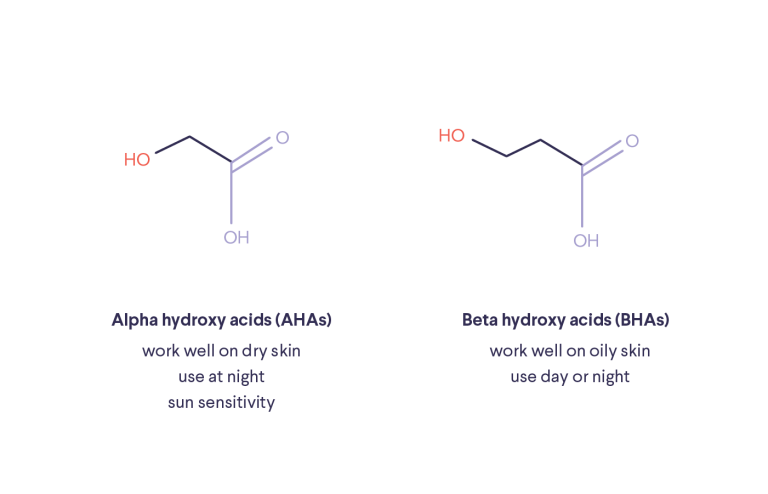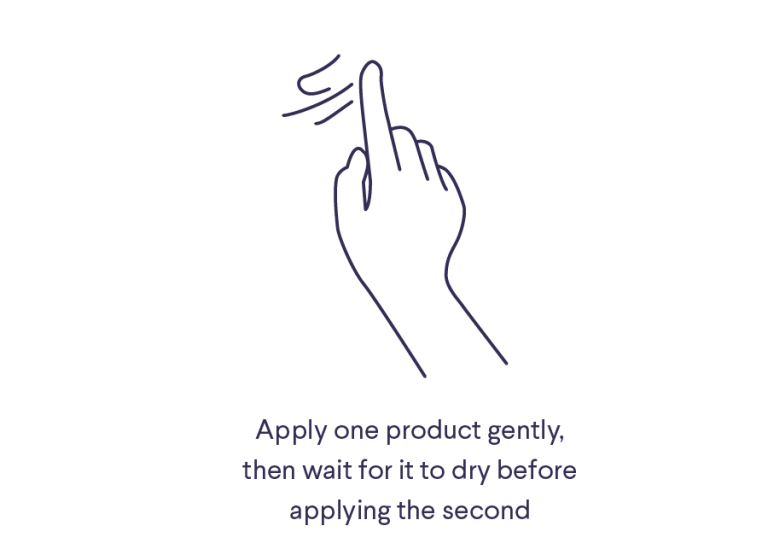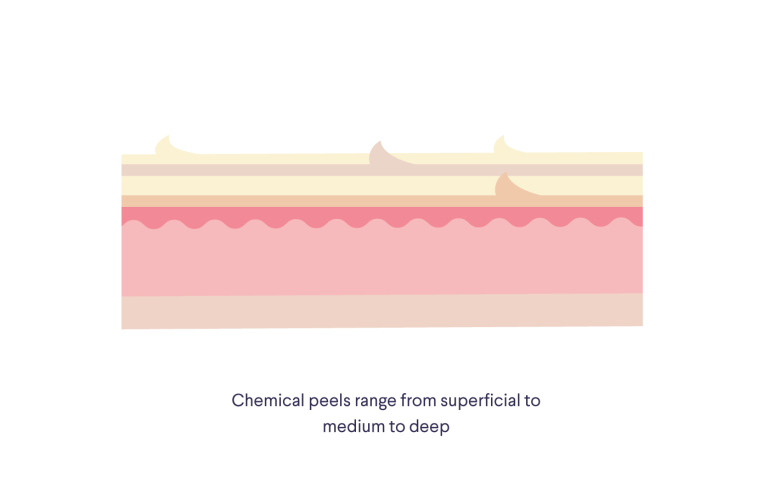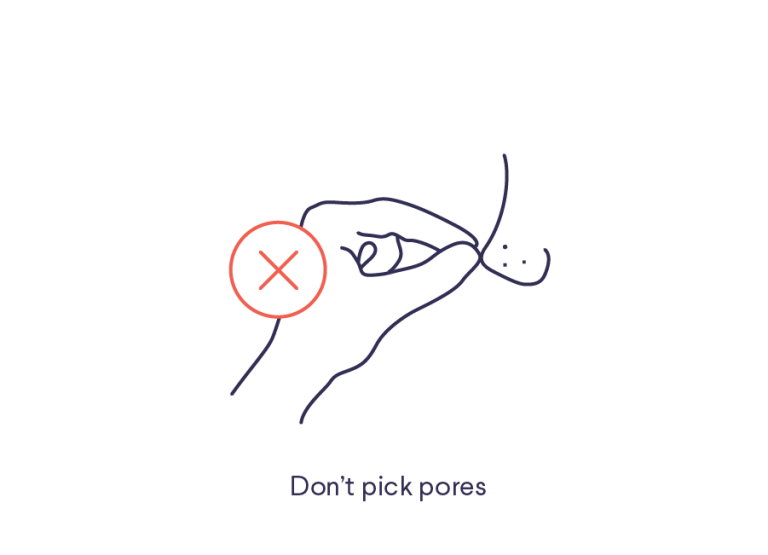How it works:
Share your skin goals and snap selfies
Your dermatology provider prescribes your formula
Apply nightly for happy, healthy skin
How it works:
How it works:
Share your skin goals and snap selfies
Your dermatology provider prescribes your formula
Apply nightly for happy, healthy skin
How it works:
Chemical exfoliation 101
Acid, peels – no scrubs.



In this article
Scrub-free Exfoliating
Chemical exfoliation is your ally in the fight against acne, but proceed with caution! Overdoing it will irritate your skin and make acne worse. Fortunately, there are lots of options, even for sensitive skin.
One of the major benefits of chemical exfoliation: no need for aggressive scrubbing. Chemical exfoliants like glycolic acid (AHA) or salicylic acid (BHA) dissolve the “cement” that holds the dead skin cells on the skin’s surface. Certain acids have bonus effects, too: Salicylic acid is chemically similar to the active component of aspirin, so it decreases inflammation, whereas glycolic acid and lactic acid exfoliate in the superficial layers of the skin, reduce hyperpigmentation, and increase collagen synthesis.
Read on for our dermatologist-approved guide to all things acid.
Acid Wash
The two most common types of chemical exfoliants are alpha hydroxy acids, or AHAs, and beta hydroxy acids, or BHAs.

Alpha hydroxy acids (AHAs) help dislodge dead surface skin cells without going deep into pores, so they work particularly well on dry skin. It’s best to use products with AHAs at night, not during the day, as they make your skin more sensitive to the sun. Always wear sunscreen if you use AHAs!
Glycolic Acid: the most popular AHA
Lactic Acid: milder than glycolic acid; moisturizes the skin while it exfoliates
Mandelic Acid: a very gentle AHA
Products
Mario Badescu Glycolic Acid Toner
Pixi Glow Tonic
Drunk Elephant T.L.C. Framboos Glycolic Night Serum
Beta hydroxy acids (BHAs) help dislodge dead surface skin cells, too. But they go even deeper into the pores to clear out more debris. BHAs work best for oily skin types. Salicylic acid is a BHA commonly found in many anti-acne products — it’s effective, but it can be drying. Unlike AHAs, salicylic acid doesn’t increase your skin’s sun sensitivity, so it can be used day or night.
Salicylic acid: helps both clogged pores as well as inflamed acne; well-tolerated by skin of color
Products
Neutrogena Oil-Free Acne Wash
Neutrogena Rapid Clear Acne Defense Face Lotion
Paula’s Choice 2% BHA Liquid
Stridex (red box) wipe for after cleansing
Tip: At night, allow your face to dry completely after using a BHA, then apply your Curology medication (or use the BHA in the morning instead).
Can I use AHA/BHA with my Curology cream?
Your Curology cream may include acne-fighting acids already, so if you have sensitive skin, the cream alone may be enough for you. It may be wise to lay off the AHAs and BHAs entirely if you have sensitive skin.
If you want a little extra kick, we highly recommend adding just one additional chemical exfoliant at a time. Try it no more often than once every few days and see how your skin reacts. If you do experience any redness, peeling, etc., hold off on the AHA or BHA for a couple weeks, then reintroduce it gradually.

The best way to combine AHAs or BHAs with your Curology night cream is to apply one product gently, then wait for it to dry before applying the second. In which order? Generally you can go with your preference — but if you’re using a toner, do that first, then follow it up with your Curology cream (and a skin-soothing moisturizer, if needed).
Other forms of chemical exfoliation:
PHAs (polyhydroxy acids): Polyhydroxy acids (PHAs, such as lactobionic acid and gluconolactone) provide similar benefits as traditional AHAs. They have a slower absorption rate, making them gentle enough for sensitive skin, and they help keep skin moisturized.
Acetic Acid (apple cider vinegar): While not typically used as an exfoliant, acetic acid is unfriendly to bacteria and encourages exfoliation, as well. To make your own apple cider vinegar toner, dilute 1 part vinegar with 4 parts water.
Citric acid: Derived from fruits, including orange, lemon and grapefruit, citric acid is usually classified as an AHA, although on rare occasions citric acid is cited as a BHA. While not considered as effective as glycolic acid as an exfoliant, it can improve photodamage and dark spots.
Retinol: It doesn’t exactly exfoliate the skin, but it does encourage normal skin cell turnover, which helps to prevent the blocking of pores.

Feel the Peel
A chemical peel is when a solution of exfoliants is applied to the skin to cause the top layer to eventually peel off. Peels range from superficial to medium to deep.
Superficial peels usually include BHA (salicylic acid) or AHA (such as glycolic acid, mandelic acid, or lactic acid). AHAs, in general, help aging changes by stimulating new collagen formation and can improve hyperpigmentation, while BHAs are thought to be especially beneficial in acne-prone skin as they are lipid soluble and penetrate into the pore, helping diminish blackheads and whiteheads.
Don’t Overdo it
Keep in mind that exfoliation is easy to overdo. While regular exfoliation can be beneficial to the skin, over-exfoliated skin is left raw, sensitive, and extra-vulnerable to irritation. Plus, it ends up looking shiny — even if you’re not oily. Light reflects off the smooth and flat over-exfoliated skin surface, creating a shiny look — whereas if the surface is a bit rough, the light scatters. Other signs that you may be over-doing it are redness, tightness, and dryness.

If your skin’s got that overly polished look, you should take a break from using any chemical or even physical exfoliation (this includes rotating brushes and overenthusiastic use of washcloths). Also hold off on your Curology medication for about 5 days, then restart every other day as you work your way back to applying it nightly. A thin layer of pure Vaseline or a sensitive-skin moisturizer can help protect your skin while it’s recovering.
Can Chemical Exfoliation Shrink Pores?
Pore size is genetic, and the size of pores typically can’t be changed. There are plenty of makeup primers and “pore perfecting” balms out there that reduce the appearance of large pores.

To keep large pores from worsening, treat acne breakouts with your Curology cream, don’t pick, and — as always — protect your skin from the sun. Sun exposure breaks down collagen, which is the support structure surrounding the pores. If you don’t shield your skin from the sun, your pores will look bigger over time!
The active ingredients available in your Curology cream may help improve the appearance of large pores. For example, azelaic acid encourages cell turnover, which helps prevent pore blockage, resulting in a smoother appearance. But again, this doesn’t literally change the size of your pores! The pore still has the potential to become just as enlarged again within days as sebum production and cell turnover continue.
Certain laser and light treatments, like Laser Genesis, may visibly “shrink” the appearance of pores by promoting collagen production or diminishing the sebaceous glands.
Some people have had success with toners to temporarily decrease the appearance of pores, although toners don’t really “tighten” pores. Toners aren’t necessary in your skincare routine, and you should probably avoid them if your skin is sensitive, but if you do want to try one, find a toner without alcohol. Thayers Rose Petal Alcohol-Free Witch Hazel with Aloe Vera is a popular choice.
Any improvement in pore size promised by clay masks, astringents, or physical exfoliators is only ever temporary. If you try these, be sure not to use them aggressively or too frequently. Remember: irritated skin = more acne!

Conclusion
Now you know — exfoliation can be of added benefit in your skincare regimen. AHAs, BHAs and certain ingredients in Curology have beneficial exfoliating properties. That said, it’s easy to exfoliate too much without knowing it. Take a minute to read the ingredients in your skincare products to be sure you aren’t unwittingly doing your skin more harm than good.
Get your personalized skincare routine with Curology
Get your personalized skincare routine with Curology


Your Curology care provider can help you figure out just what chemical exfoliants (if any) will be safe to try in addition to your night cream treatment — just upload selfies with updates periodically so they can monitor for any possible signs of irritation. The trial-and-error process is a delicate but necessary part of your unique skincare journey, and we’re here for you every step of the way.
We’re here to tell you what we know. That’s why our information is evidence-based and fact-checked by medical experts. Still, everyone’s skin is unique—the best way to get advice is to talk to your healthcare provider.
Empowering you with knowledge is our top priority. Our reviews of other brands’ products in this post are not paid endorsements—but they do meet our medically fact-checked standards for ingredients (at the time of publication).

Curology Team